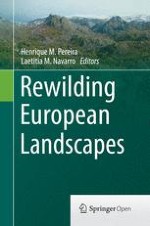Open Access 2015 | Open Access | Buch

Rewilding European Landscapes
herausgegeben von: Henrique M. Pereira, Laetitia M. Navarro
Open Access 2015 | Open Access | Buch

herausgegeben von: Henrique M. Pereira, Laetitia M. Navarro
Some European lands have been progressively alleviated of human pressures, particularly traditional agriculture in remote areas. This book proposes that this land abandonment can be seen as an opportunity to restore natural ecosystems via rewilding. We define rewilding as the passive management of ecological successions having in mind the long-term goal of restoring natural ecosystem processes. The book aims at introducing the concept of rewilding to scientists, students and practitioners. The first part presents the theory of rewilding in the European context. The second part of the book directly addresses the link between rewilding, biodiversity, and habitats. The third and last part is dedicated to practical aspects of the implementation of rewilding as a land management option. We believe that this book will both set the basis for future research on rewilding and help practitioners think about how rewilding can take place in areas under their management.